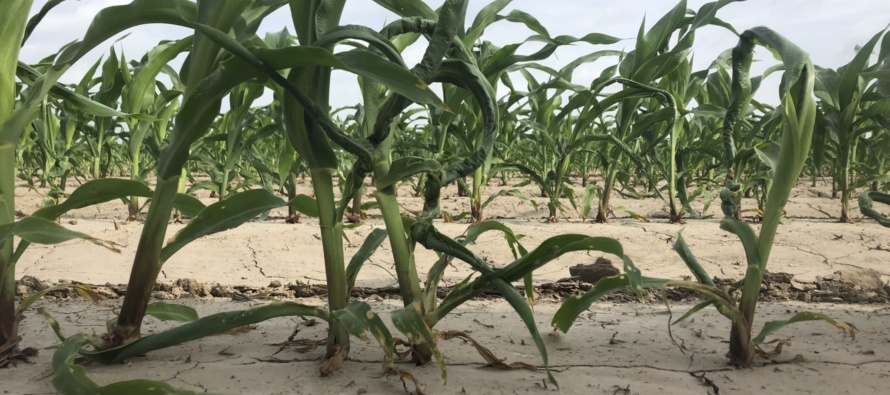Corn Disease Update: July 22, 2019

Related Articles
- 2010 Soybean And Corn Variety Trial Data 3
- Rice Variety Trial Results For 2010, Plus Rice Research Report 0
- Evaluation of Peanut Prescription Rx Program in Mississippi 0
Latest Tweets
Curvularia leaf spot
For whatever reason, Curvularia leaf spot has become more commonplace in the MS corn production system over the past several seasons. I suspect our observations of Curvularia leaf spot is directly related to rainfall patterns as well as hybrid susceptibility. Several weeks ago I received a few calls regarding the eyespot throughout the MS Delta. In general, we do not have eyespot in MS, nor in the southern U.S. However, the confusion could easily occur as a result of the numerous diagnostic guides that are widely available and contain multiple photos of eyespot because this can be a problem in the midwest. Comparing the photos presented in diagnostic guides can oftentimes be a good way to determine what is in the field; however, the photos associated with some diseases can be misleading as to the particular disease issues we encounter throughout MS or within certain regions of the country. Eyespot is a northern disease that prefers cooler temperatures. Due to the general lack of information on Curvularia leaf spot there are a low number of photos available on the internet. In addition, until a few years ago, Curvularia leaf spot was considered a disease of minor importance that predominantly occurred in Central and South America, more tropical areas with corn production. In addition, there are very few photos of Curvularia leaf spot available on the internet since this disease has not been a common occurrence outside of tropical parts of the world.
Northern corn leaf blight
Not as commonly observed this year, and in situations where it has been observed has been quite limited. I am sure there are some places where NCLB has appeared to be an issue, but rarely does NCLB present a yield-limiting situation. Most commercially available corn hybrids in our production system have some level of tolerance. The hard part about NCLB is the disease will get worse as the corn matures. Rarely have I observed a situation where I was concerned with the level of NCLB presenting in the field. Be mindful that corn plants have a large amount of leaf surface area and therefore one to two lesions on the upper leave, even if that’s on the same leaves will likely not result in a yield reduction associated with NCLB.
Southern corn leaf blight
The incidence of southern corn leaf blight has certainly increased this season. However, much like anthracnose and some of the other diseases encountered in the lower canopy (see: https://www.mississippi-crops.com/2019/06/15/corn-disease-update-june-14-2019/), southern corn leaf blight is typically a disease that does not result in a yield-limiting situation. Moreover, rarely have I observed southern corn leaf blight go above the ear leaf. Be mindful that the leaves in the lower corn canopy are nutritionally stressed and typically support fungi since the environment is conducive for them to develop.

Southern corn leaf blight. Note the differences between this disease and gray leaf spot. SCLB will produce more wavy lesions that cross the veins.
Southern corn leaf blight
The incidence of southern corn leaf blight has certainly increased this season. However, much like anthracnose and some of the other diseases encountered in the lower canopy (see: https://www.mississippi-crops.com/2019/06/15/corn-disease-update-june-14-2019/), southern corn leaf blight is typically a disease that does not result in a yield-limiting situation. Moreover, rarely have I observed southern corn leaf blight go above the ear leaf. Be mindful that the leaves in the lower corn canopy are nutritionally stressed and typically support fungi since the environment is conducive for them to develop.
Southern rust
Over the past two weeks, southern rust has been observed in an increasing number of fields in western MS. However, in most of the situations the corn was either at a stage where it was no longer threatened from southern rust (beginning dent, or close to dent), or the number of pustules present in the corn canopy was enough to clearly identify the presence of southern rust (in several instances single pustules on leaves). In most cases, corn that has reached advanced growth stages, such as milk (R3) or dough (R4) is likely at a safe growth stage and will not see a yield loss associated with southern rust. All diseases, even southern rust, will require a period of time to build up enough inoculum to cause issues even in the fields where the disease was initially observed. However, I realize that there is likely some corn in our production system that is either just beginning to tassel or has a little longer to go. Protecting that corn may be important; however, there are several
Fungicide applications in response to southern rust have been a topic of conversation for the past several years. Determining the best growth stage for making the most out of a single fungicide application is an even more common topic of conversation. Corn that has not yet tasseled (a small number of acres) will most likely benefit from a carefully timed fungicide application with a dual mode of action product (at a minimum). Scout and make decisions based on the presence of disease in a field or proximity to disease rather than making automatic applications in response to hearsay.
In the past reports of southern rust from throughout the corn production area have been handled on several websites. A shift to a new website that should be easier to access via mobile phone occurred over the past several weeks. The new website will be easier for plant pathologists to access and upload data regarding southern rust observations. The website can be accessed at: https://corn.ipmpipe.org/southerncornrust/






Let me tell You a sad story ! There are no comments yet, but You can be first one to comment this article.
Write a comment